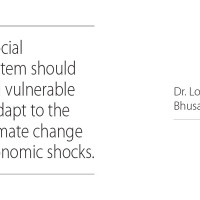- Friday, 19 April 2024
Impact Of Interest Hikes On Cooperatives
Commercial banks have recently hiked the rates of interest on deposits with a view to wooing deposits to cope with the liquidity crisis they have been in for a long time. They have increased the rate of interest on fixed deposits to 12.13 per cent per annum, up from 11.03 per cent per annum. There was a gentlemen agreement among the commercial banks not to increase the rate of interest on deposits on their own. The understanding has now been breached by the commercial banks and they are free to determine the rates of interest on their deposits. However, the rate of interest on fixed deposits has been hiked by one per cent as per the criteria set by the Nepal Rastra Bank.
Likewise, the rate of interest on remittance fixed deposits has been fixed at 13.13 per cent per annum. One of the banks has fixed it at as high as 15.13 per cent. The banking sector has been facing the liquidity crisis, or rather a dearth of loanable funds, for a long period of time. The commercial banks have introduced several deposit schemes, including one involving deposits attracting a ten-fold increase in a certain period of years. In a sense, they are in the rat race to mobilise deposits to the extent possible. The recent hikes in interest rates are part of the deposit mobilisation scheme.
Attractive dividends
The commercial banks are operating mainly with a view to increasing their profits as the promoters and shareholders seek attractive dividends in return for their investments in the banks. The paid-up capital of the banks has increased drastically. There are 26 commercial banks now. The paid-up capital ranges from Rs. 9.03 billion to Rs. 23.79 billion per bank. The interest hikes have brought about ripples across the cooperative sector. Cooperatives have limitations and limited resources. Their sources of income are loans unlike commercial banks that can earn not only from loans but also from other sources such as letters of credit, bank guarantees documentary credits and other fees and commissions.
Further, the cooperatives cannot charge interest more than 16 per cent on loans as the reference interest (lending) rate is fixed at 16 per cent. No such reference rate is there for the commercial banks. As the rate of interest on fixed deposits is 12.13 per cent per annum in the commercial banks, the cooperatives are under pressure to increase such a rate to at least one per cent above the rate of the commercial banks. This may be 13.25 to 14 per cent or above. As the reference interest (lending) rate is fixed at 16 per cent, there will be a very narrow margin between the deposit and lending rates. It may be very difficult for the cooperatives to survive on such a meagre margin.
If the cooperatives fail to give attractive interest rates, it is most likely that the deposits in the cooperatives will get diverted to the commercial banks. People choose cooperatives because they can get higher interest rate than that from commercial banks. They also approach cooperatives because they can easily avail themselves of loans because of simple andhassle-free lending procedures. The government has considered the cooperative sector as one of the pillars of the national economy. There are over 34,000 cooperatives throughout Nepal. Most of the cooperatives are facing difficulties owing mainly to the members’ not repaying loans.
The reference interest (lending) rate has also created problems for the cooperative sector. Yes, some cooperatives have been found indulged in dishonest activities. They have charged more than the reference interest rate on loans. They have also charged unconscionable service charges on loans. But not all the cooperatives should be treated alike. Monitoring the cooperatives is a must. And action must be taken against the erring cooperatives. The cooperatives feel that the reference interest rate should be increased. In the present scenario, it will be difficult for them to survive, let along make profits.
When the deposits go down, they may not be able to provide loans for their members. As long as the rate of interest on deposits is not hiked, it will be difficult to retain the existing deposits, much less to attract new deposits. However, the Department of Cooperatives and the Nepal Federation of Savings and Credit Cooperative Unions Ltd. (NEFSCUN) are not ready to address the demand of the cooperatives that the reference interest (lending) rate be hiked. NEFSCUN is the apex organisation of savings and credit cooperatives and their district unions. As per the Department of Cooperatives, the Reference Interest Determination Committee has constituted a sub-committee, which is studying the reference interest rate.
Liquidity crisis
It is anybody’s guess when the liquidity crisis in the banking sector will come to an end. It is obvious that the cooperatives will find it heavy going to run under the present circumstances. The only option seems to be an increase in the reference interest (lending) rate. But the Department of Cooperatives and NEFSCUN have clearly said that it cannot be hiked and that they have to adhere to the rules and regulations. The intention of the Department of Cooperatives is that the ailing and other cooperatives go into a merger. It has been several years since the process of mergers in the cooperative sector was broached. There are also sporadic cases of mergers. Anyway, being the regulatory body, the Department of Cooperatives should take concrete measures to save the cooperatives from being collapsed, which may ensue sooner or later if the reference interest (lending) rate is not revised.
(Maharjan has been regularly writing on contemporary issues for this daily since 2000. uttam.maharjan1964@gmail.com)















